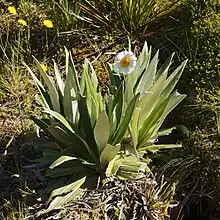| Hierodoris eremita | |
|---|---|
 | |
| Scientific classification | |
| Domain: | Eukaryota |
| Kingdom: | Animalia |
| Phylum: | Arthropoda |
| Class: | Insecta |
| Order: | Lepidoptera |
| Family: | Oecophoridae |
| Genus: | Hierodoris |
| Species: | H. eremita |
| Binomial name | |
| Hierodoris eremita | |
Hierodoris eremita is a moth of the family Oecophoridae.[1] It is endemic to New Zealand and found in the areas around Aoraki / Mount Cook and Westland Tai Poutini National Park areas. This species inhabits alpine herbfields at altitudes of around 900–1400 m. Larvae are said to have been reared on the leaves of plants in the Celmisia genus. Pupation happens on the host plant. The adults of this species is on the wing between December and June. This species is day flying.
Taxonomy
This species was described by Alfred Philpott in 1930 using five female specimens collected in December at Hooker Valley and Ball Glacier Hutt.[2] The holotype specimen is held at the Canterbury Museum.[1]
Description
.jpg.webp)
As at 2005 the larvae have not yet been described.[1]
Philpott described this species as follows:
♀. 22-24 mm. Head whitish-ochreous. Palpi, ochreous-whitish mixed outwardly with brown. Antennae whitish, closely annulated with fuscous. Thorax leaden white. Abdomen whitish-ochreous. broadly banded with dark fuscous dorsally. Legs ochreous white. Forewings oblong, costa strongly arched, apex broadly rounded, termen rounded, not oblique; shining white, faintly ochreous tinged towards termen: fringes white. Hindwings ochreous white, iridescent; apical half fuscous: fringes white.[2]
Philpott noted that the female specimens he was using to describe the species were very similar in appearance to moths in the Gelophaula genus.[1]
Distribution
This species is endemic to New Zealand and is found around the Aoraki / Mount Cook and Westland Tai Poutini National Park areas in the Westland and Mackenzie districts.[1][3][4]
Behaviour
Pupation happens on the host plant.[1] The adults of this species is on the wing between December and June.[5][4] This species is day flying.[4][1]
Habitat and host species

This species inhabits alpine herbfields at altitudes of around 900–1400 m.[1] Larvae are said to have been reared on the leaves of Celmisia coriacea from which they had been collected at the Sealy Range.[4][1] The larvae feed on the underside of the leaves of their host plant.[1] In 1980 the taxonomy of Celmisia coriacea was revised.[6] This species is only found in Fiordland and Southland.[7] Celmisia coriacea is often confused with Celmisia semicordata, a similar looking species with a wider range, including the area around Aoraki / Mount Cook.[7]
References
- 1 2 3 4 5 6 7 8 9 10 11 Robert J. B. Hoare (24 December 2005). "Hierodoris (Insecta: Lepidoptera: Gelechioidea: Oecophoridae), and overview of Oecophoridae" (PDF). Fauna of New Zealand. Manaaki Whenua – Landcare Research. 54: 32–33. doi:10.7931/J2/FNZ.54. ISSN 0111-5383. OCLC 946510444. Wikidata Q44994400. Archived from the original (PDF) on 20 February 2021.
- 1 2 Alfred Philpott (30 August 1930). "The Lepidoptera of Mount Cook District, with Descriptions of New Species" (PDF). Transactions and Proceedings of the Royal Society of New Zealand. 61: 438. ISSN 1176-6166. Wikidata Q66085040.
- ↑ "Hierodoris eremita Philpott, 1930". www.nzor.org.nz. Retrieved 2021-11-12.
- 1 2 3 4 Sweney, W. J. (1980). Insects of Mount Cook National Park (MAgSci thesis). Lincoln College, University of Canterbury. hdl:10182/4038.
- ↑ George Vernon Hudson (1939), A supplement to the butterflies and moths of New Zealand, Illustrator: George Hudson, Wellington: Ferguson and Osborn Limited, pp. 456–457, OCLC 9742724, Wikidata Q109420935
- ↑ David R. Given (March 1980). "A taxonomic revision of Celmisia coriacea (Forst.f.) Hook.f. and its immediate allies (Astereae-Compositae)". New Zealand Journal of Botany. 18 (1): 127–140. doi:10.1080/0028825X.1980.10427239. ISSN 0028-825X. Wikidata Q55756358.
- 1 2 "Celmisia coriacea". New Zealand Plant Conservation Network. Retrieved 2021-11-13.